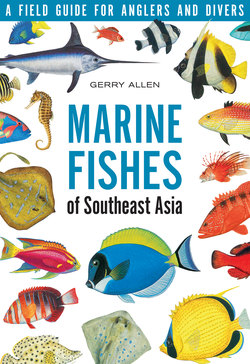Читать книгу Marine Fishes of South-East Asia - Gerry Allen - Страница 9
На сайте Литреса книга снята с продажи.
ОглавлениеINTRODUCTION
There are approximately 22,000 types of fishes inhabiting our planet, including approximately 13,500 marine species. Seas encompassing northern Australia and the tropics that lie immediately northward are inhabited by the richest fish fauna on earth. Official counts are lacking, but an estimated 4,000 species occur in the region, or about 30 per cent of the world’s total marine fishes. For most families of tropical marine organisms there are more species represented in this area than any place on earth. For example, among the reef-dwelling damselfishes, a family containing about 330 species worldwide, about 175 species or over 50 percent of the world’s total inhabit the region sometimes referred to as the Indo-Australian Archipelago.
Why is this region populated by so many species? No doubt a combination of several factors are responsible. Certainly among the most important are a lengthy history of favourable climatic conditions (ie., warm water), a diversity of habitat types, and a tumultuous geological and hydrological past. In the latter category events such as sea level changes, ocean current shifts, volcanism, and continental drift have created isolating barriers that greatly enhanced the speciation process.
One of the most significant factors responsible for the region’s great plethora of fishes and other marine organisms is its vast tropical shoreline with an array of diverse habitats. Coral reefs are the most complex habitat system. They provide abundant living space and seemingly endless “survival opportunities” for a wealth of creatures. Spires of tabular and branching corals are the reef’s equivalent of multi-story tenements. Not only do they house thousands of living polyps, they also serve as a retreat for legions of brightly coloured fishes that swarm above. Ledges, caves and crevices form the inner sanctum of the reef city, which is populated by shy, seldom seen fishes that may only emerge for night-time feeding patrols.
The sand and rubble fringe surrounding individual reef complexes appears devoid of fish life. But first impressions are deceptive. Close inspection reveals an entire community of specially adapted species. Although this habitat contains far fewer fishes than nearby reefs, its inhabitants are equally interesting. Common adaptations include camouflage colouration and burrowing behaviour. Other major habitats in the region include inshore coastal environments - vast stretches of sandy or rocky shores, interspersed with estuaries and coastal mangroves - and open offshore oceanic habitats. All of these zones are populated by distinct fish communities.
The book contains nearly 2,000 hand-painted illustrations featuring 1,635 individual species. The paintings were completed over a 3-year period and are primarily based on photographs or colour transparencies of either live fishes taken underwater or freshly caught specimens. In many cases preserved specimens at the Western Australian Museum have been consulted to ensure accuracy of detail and proportions. The end result is a colourful and highly comprehensive guide to the sea fishes of northern Australia and the adjacent South-east Asian region.
